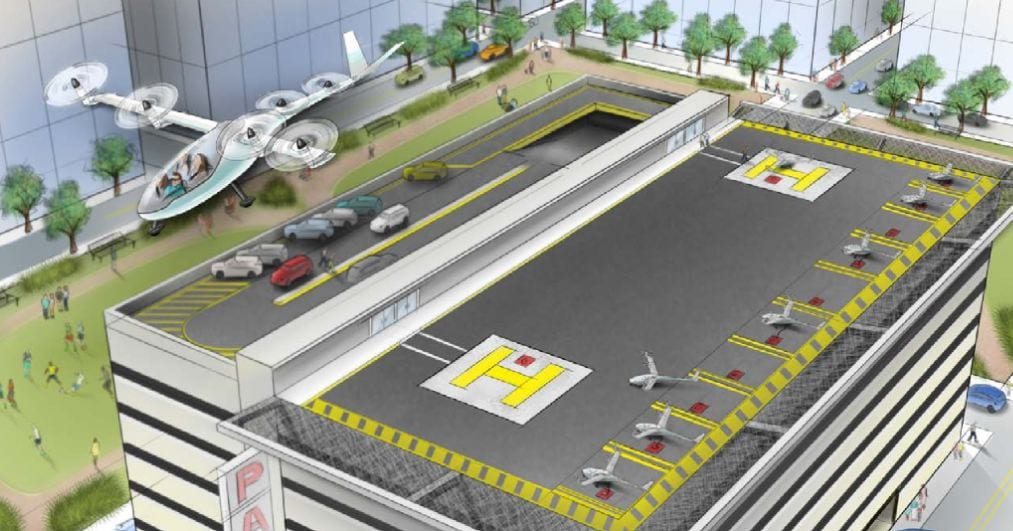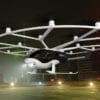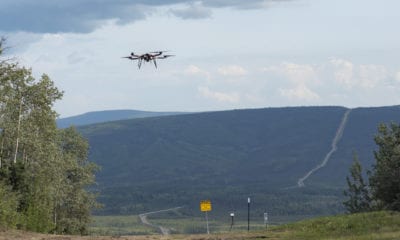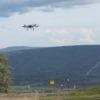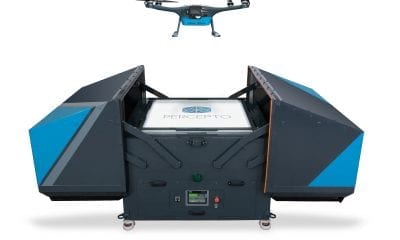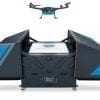Uber Extends Partnership with NASA, Unveils Flying Taxi Ridesharing Prototype
Ridesharing in the sky looks set to take off with the unveiling of Uber’s prototype electric flying taxi at the Uber Elevate Summit 2018 this week – and it looks like a giant drone.
Hardly a new concept, the disruptive transport company first released its whitepaper on the topic in October 2016. Then, they imagined saving commuters hours of travel time by crossing cities in a matter of minutes.
Now, Uber are launching into a plan to make this concept reality within two to five years, reported CNBC.
The flying taxi service, to be known as UberAIR, would cost the same price as an UberX trip of the same distance, says the company. Taking off and landing vertically from skyports (much in the same manner proposed by Volocopter last month, it has to be said), passengers would travel in the flying taxis at speeds of up to 320km/hr.
Right now, we are working on a new era in air transportation: Urban Air Mobility→https://t.co/LIeZwmEoEy #FlyNASA #Elevate18 pic.twitter.com/2xnrlnA07Y
— NASA Aeronautics (@NASAaero) May 8, 2018
While the VTOL UberAIR vehicles at first are to be piloted, Uber will move over to autonomous flight in the future.
“On-demand aviation, has the potential to radically improve urban mobility, giving people back time lost in their daily commutes. Uber is close to the commute pain that citizens in cities around the world feel,” say the company in the whitepaper.
According to studies, Sydney residents spend 35 working days a year commuting to work, two of which are completely wasted stuck in traffic, while in 2017 congestion in Los Angeles costs drivers an average of $1445 per driver, per year.
With congestion an ever-growing problem, it is apparent that it is paramount that better urban mobility solutions are developed to counter traffic in populated areas.
To this end, NASA and Uber have also announced the signing of a second space act agreement by which they intend to explore and develop urban air mobility (UAM) technologies to address these issues.
The agreement will see Uber share its urban aviation rideshare solutions with NASA, who would in turn use airspace management computer modeling and simulation to work out how these and other small VTOL aircraft would impact on low altitude urban airspace.
Its the first agreement with NASA specifically focused on modeling and simulating UAM operations. Jaiwon Shin, associate administrator for NASA’s Aeronautics Research Mission Directorate expressed NASA’s enthusiasm about the partnership.
“NASA is excited to be partnering with Uber and others in the community to identify the key challenges facing the UAM market, and explore necessary research, development and testing requirements to address those challenges,” he said.
'Urban air mobility #UAM could revolutionize the way people and cargo move in our cities and fundamentally change our lifestyle much like smart phones have' - Jaiwon Shin NASA Click To Tweet
The UberAIR rollout is expected to be initially carried out in Dallas Fort Worth (DFW) and Los Angeles by 2023, with testing beginning as soon as 2020.
NASA will use the data supplied by Uber to simulate a small passenger-carrying aircraft in air traffic peak hour at its research facility at the DFW International Airport. This will enable them to analyse simulations to identify any possible safety issues.
Uber, who have recently come under a great deal of fire after their driverless car killed a woman crossing a road during testing in Arizona, are keenly aware of the need for public trust to be regained in order for their UberAIR project to achieve success. It now appears that the car’s sensors detected the woman but recognised her as a “false positive” and made a decision not to swerve.
No doubt considerable and vigilant testing and analysis will be undertaken to ensure similar incidents do not occur with UberAIR – which is where NASA’s decades of experience in aerospace will surely be of assistance.
So far, UberAIR have built in a redundancy plan should any of the rotors of its eVTOL taxi fail.
Speaking with CNBC, Uber’s chief product officer Jeff Holden, explained how this would work. “It’s got four what are called stacked rotors, so 8 rotors in total, so its a very safe design because if one of these rotors fails the aircraft is still completely flyable,” he said.
NASA’s priorities are safety and smooth, quiet integration into the current national air traffic control system. Current and ongoing research into low altitude airpsace management of unmanned systems, electric aircraft and VTOL capabilities will be leveraged to achieve this goal.
In the meantime, we can’t help but wonder – while the launch video made by CNBC shows a passenger ordering an UberAIR vehicle via the familiar Uber smartphone app – could we also see hailing of air taxis using a combination of shouting and waving hands such as filed in a driverless ground-based taxi patent by Uber just two months ago? The mind boggles.

